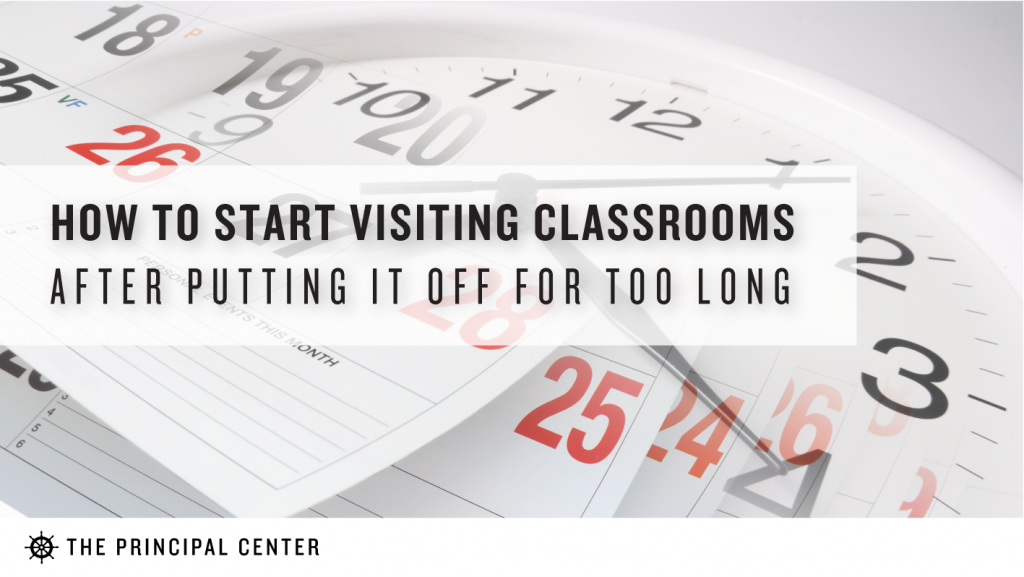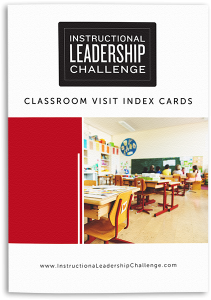
How can you start getting into classrooms mid-year, after several months have gone by?
It feels a bit like forgetting someone's name five minutes into a conversation and having to ask “What was your name, again?”
Awkward.
“Hey everyone…so, we all know I should have been getting into classrooms all year, but now I'm REALLY going to start…really!”
Don't despair. You can start getting into classrooms at any time of year, without making it awkward, triggering teacher resistance, or setting up unrealistic expectations.
Overcoming the Awkwardness
The awkwardness of starting to visit classrooms—after months of failing to make time—can make it feel safer not to even try.
And make no mistake: this is the norm in our profession.
Most school leaders rarely, if ever, visit classrooms—except when they're required to, as part of the teacher evaluation process. (And even then, not everyone meets all of the minimum requirements.)
But we feel a certain pull to visit classrooms. We know it's where we truly belong if we want to be instructional leaders, because visiting classrooms gives us our best opportunity to have an impact on teaching and learning.
Still, we can resist that pull when faced with the awkwardness of finally getting around to something we've been putting off for too long.
Let's just be honest about the reactions we're likely to get:
“Oh…what brings you here?”
“Can I help you with something?”
“Are you here for a student?”
Or even the dreaded deadpan from first-year students:
“Who are you?”
Ouch!
But there's one simple thing you can do to overcome the discomfort of your first visit:
Be interested.
Show a genuine interest in what students are learning, what they're doing, and how the teacher is making it all happen.
Express genuine curiosity about the learning that's taking place. Smile, nod, and show enthusiasm.
And for Dewey's sake, leave forms and clipboards out of it. Don't bring anything along—not a laptop, not a tablet, not a clipboard with a 2-part form.
Just show up, pay attention, and express interest.
When instructional leaders express interest in teaching and learning, no one is surprised (even if it's the first time), because it just seems like what we're supposed to be doing.
A form on a clipboard, or an app running on your iPad, sends a different message:
“I'm required to do this. It's a formality. I'm here because I'm up against a deadline.”
But if you show up with just yourself—your curious, interested, cares-about-learning instructional leader self—the awkwardness melts away quickly.
Skip the Grand Announcement

What you don't need to do is make some sort of big announcement. You don't need to issue a mea culpa that draws attention to your sparse classroom visits.
You don't need to promise to do better, or outline an ambitious schedule that sets you up to fail.
“I'm so sorry I haven't been in classrooms as much as I've wanted to. I've just been very busy with the start of school, and our new initiative, and our accreditation visit, and, and, and…I'm going to visit classrooms for four hours a day, every day for the rest of the year to make up for it.”
Forget the apologies and the promises, and just get started.
When you show up and express interest, teachers get used to it quickly. They'll be glad to see you, and they'll understand if you don't make it around as often as you'd like.
But to go beyond making an appearance, and truly make your visits valuable, you'll eventually need to start asking questions—and the questions you ask will determine whether teachers are happy to see you—or whether they put up a fight.
Preventing Teacher Resistance to Classroom Visits
Some teachers aren't just surprised to see you when you start visiting classrooms—they're downright hostile.
That's why it's so important to show up empty-handed during your first few visits—no forms, no apps, no technology. Just be present and pay attention.
(Smiling doesn't hurt, either!)
If teachers understand that you're not visiting to conduct a “gotcha” evaluation, they'll be more open to actually talking with you and helping you understand what you're seeing. But it's hard to overcome teachers' suspicions when you suddenly increase the frequency of your visits.
Here are three things teachers need to know, in order to trust that your intentions are positive:
- You aren't singling me out—you're treating everyone the same
- You aren't compiling a secret file on me
- You aren't judging me without understanding the context of what you're seeing
In the High-Performance Instructional Leadership model, I recommend visiting all teachers on a consistent rotation—three classrooms a day, every day. In most cases, this will get you around to every teacher about once every two weeks.
It's essential to visit everyone in the same order each time, and not to skip anyone, because teachers will start asking around:
“Hey, she's been in my room twice this month. Is it just me, or is she visiting your classes, too?”
The “Is it just me?” question is how teachers decide whether they're being singled out, or whether you're just doing a better job than ever of getting into classrooms.
If you visit teachers haphazardly, without keeping track, it's likely that you'll make it around to certain teachers more often than others—and this can spell disaster if teachers start to panic.
To make sure you stick to a consistent rotation, and don't skip anyone, I highly recommend keeping track of your visits, with a system like these notecards.
On the back of these notecards, you'll find 10 evidence-based questions for asking teachers about their practice, without triggering defensiveness:
- Context: I noticed that you [ ]…could you talk to me about how that fits within this lesson or unit?
- Perception: Here’s what I saw students [ ]…what were you thinking was happening at that time?
- Interpretation: At one point in the lesson, it seemed like [ ] …What was your take?
- Decision: Tell me about when you [ ] …what went into that choice?
- Comparison: I noticed that students [ ] …how did that compare with what you had expected to happen when you planned thelesson?
- Antecedent: I noticed that [ ] …could you tell me about what led up to that, perhaps in an earlier lesson?
- Adjustment: I saw that [ ] …what did you think of that, and what do you plan to do tomorrow?
- Intuition: I noticed that [ ] …how did you feel about how that went?
- Alignment: I noticed that [ ] …what links do you see to our instructional framework?
- Impact: What effect did you think it had when you [ ] ?
Relationships Before Rigor
You'll find that the questions in the PDFs above soon take you deep into teachers' thinking and decision-making.
But it's OK if your first few visits are cordial, but lacking in depth. Conversations about professional practice can be powerful, but it takes time, trust, and relationships to truly get to the good stuff.
As you're getting started, be OK with ambiguity. Don't demand closure in the form of next steps or promised follow-up.
It's perfectly fine to end a conversation with “OK, well, great to see you today!”
That's how normal relationships work—you don't always say goodbye to friends by making a firm plan for your next get-together. Sometimes you just say “Bye!” …and that's it, until you run into each other again.
We might feel compelled to be more formal when we're working with teachers we supervise and evaluate, but we don't have to be.
Focus on relationships first, and teachers will be more willing to share their thinking in subsequent conversations.
Try It!
So if you've been putting off classroom visits for far too long, today is a great day to get started. Download the notecards, and leave early for your next supervision duty. Stop by a classroom on the way to the cafeteria or the playground.
Smile, express interest in what students are doing. Chat with the teacher if you have a chance.
And let me know how it goes! Hit me up on Twitter @eduleadership if this article is inspiring you to start getting into classrooms.

